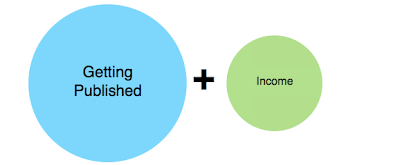“Rich are the records . . . with stories of penniless authors, who, sick with hope so long deferred, and at last despairing, have resorted to wild and tragic devices . . .”
So begins a story in the Los Angeles Examiner,New Year’s Eve edition, December 31, 1905. The feature tells the tale of one such desperate author, a school teacher named Edith Allonby. For four years she’d labored on a novel, The Fulfilment [spelled with one “l”] into which she poured heart and soul. She had been published before, but her books had not been hits. The Fulfilment was going to change all that. In fact, Miss Allonby was certain its spiritual themes would change the world. (Indeed, she thought the book had been given to her by God, so the pressure was on).
But the book was rejected. First, by her own publisher. Then by all the other publishing houses she sent it to. “I have submitted my book to all these men,” she wrote in a note. “I have tried in vain. They will not accept it, yet shall ‘The Fulfilment’ reach the people to whom I appeal, for I have found another way.”
After finishing the note, Miss Allonby changed into a silk evening gown, put fresh flowers in her hair, and sat in a comfortable chair. She was found dead the next day, her manuscript on her lap and an empty bottle of carbolic acid at her side.
And so it has been for countless authors for hundreds of years. Not normally ending in suicide (though such cases exist) but often in frustration, depression and despair. (The Fulfilment, BTW, was published in a limited edition after Miss Allonby’s death).
There was one primary reason for all this distress: Their fate as writers was not in their own hands. To get anywhere close to “success” they had to be accepted by an established publishing house (which alone had the means to produce and distribute a book), and then hope that they earned some money for their efforts.
Those two things—acceptance and income—defined writing success.
Included under “Getting Published,” we can list some ancillary things writers hope for. Like getting on a bestseller list. Perhaps being nominated (even winning) a prestigious award. Maybe just the feeling of being part of an exclusive club.
But now we are experiencing a sea change on the other side of the diagram:
We all know the traditional model is shrinking. Advances on new contracts are at historic lows. With physical shelf-space disappearing, print revenues are down. While digital income is up for the publishers, the slice of that pie given to authors remains stagnated at 25% of net (or roughly 17.5% of retail). And new writers are finding publishers increasingly risk averse regarding debut authors.
Still, many writers remain focused on that left circle. It represents some sort of “validation” even though it could very well mean less income (the right circle) and fewer readers.
But now a new model of writing success has appeared. Writers, for the first time since the troubadour era (when you could go out on your own and make up stories in song and take in some coin), have it within their power to get their writing out there without a middleman (the fancy term is “disintermediation”).
And further, unlike self-published authors of yore, they actually have a chance to make real dough. Every day we are hearing more accounts of self-published writers who are earning significant income as independents.
Yet income alone is not the main draw of this new model, which looks like this:

Freedom is the invaluable commodity here. To be able to write what you truly want to write, and know that you can get it into the marketplace, is tremendously liberating. It is, in fact, the engine of happiness for a writer. It’s exhilarating to write for yourself, see what you’ve written, fix it, and keep on writing—and be assured that it will have a place in the stream of commerce, for as long as you live.
This does not mean that going the traditional route is a spurious view of “success.” If one seeks that validation, it’s there to be pursued. The point is, however, that it is no longer the only game in town. Which is why I am more jazzed about being a writer than ever. Not just because of increased production and income, but because of the freedom to take responsibility for my own work.
Let me be quick to point out, however, that this responsibility carries challenges. Being in charge means you are CEO of your own company. You alone are in charge of quality control and production. You can expect to experience the stresses and strains of running a small business. You will need new skills to handle them. These can be acquired, but only through effort and self-discipline.
But it’s more than worth it to be holding the reins of your own writing and life.
I think Miss Allonby would have felt that way, too. Had she been able to self-publish, she might have lived a long, full life. Maybe she’d have written many more books, grown a readership, and made some money, too.
I can say this because, in one of life’s ironic and poignant turns, The Fulfilment by Edith Allonby is now available for the Kindle.
So how would you define success as a writer?










